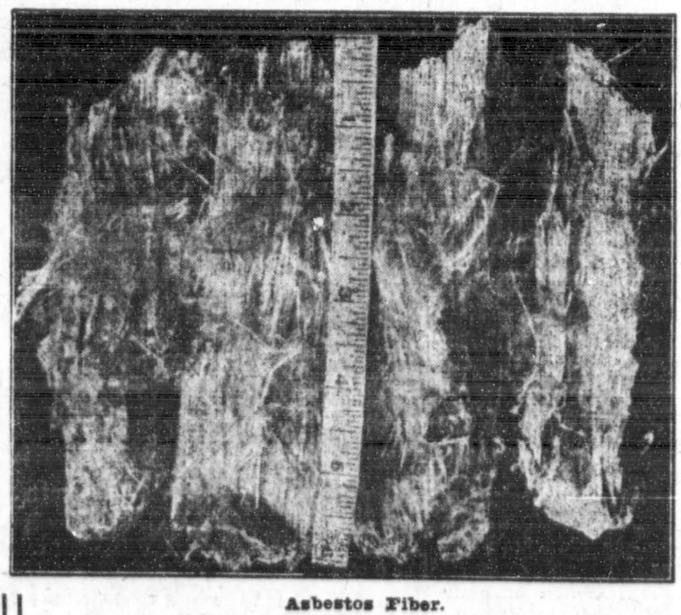
We thought asbestos was the greatest thing. It doesn’t burn and it had a zillion commercial uses. There was money in asbestos, and people were ready to mine it from wherever they could find it.

Philippines Are Rich In Asbestos Mineral
That the Philippine Islands are wonderfully rich in potential mineral wealth is being demonstrated from time to time as reports of new discoveries are made public. Gold mining was the first of this class to receive attention, possibly for the reason that the presence of this precious metal in placer ground had been evidenced for years prior to American occupation.
With the American troops that came to the islands were many conversant with mining in its various branches, and a number of these began immediately the work of prospecting for gold or undertook the operation of claims that had already been located or developed. This work was extended from placer to quartz mining, and as a result we now have a number of substantial quartz mines that are producing considerable quantities of gold, the present development of which gives assurance of a supply of ore sufficient to return large revenue for many years to come.
It is well known that there are extensive iron and copper deposits at various points in the islands, although these have been worked but little. Among the non-metallic minerals, the presence of which in large deposits has been amply demonstrated, are asphalt, sulphur, oil and asbestos.
A number of years ago reports were received in Manila to the effect that there were deposits of asbestos in the province of Ilocos Norte, and in 1906 Dr. W.D. Smith, then geologist of the bureau of science, made a technical reconnaissance and reported that evidence was plentiful of the existence of considerable quantities of asbestos at a place called Dungon-Dungon.
Several years passed from the time this discovery was reported before any attempt was made to develop these asbestos deposits. In the meantime, the property on which they were located had been acquired and was improved for plantation purposes. Coconut and mulberry trees were planted in considerable numbers and a sawmill was erected — the supply of logs being furnished partly by timber growing on the property itself and in part by a timber concession adjoining.
About six months ago the property changed hands and passed to the control of Messrs. C.D. Squires, John Northcott and Chas. S. Banks, the last named having for a number of years been connected with the bureau of science, Manila, and the other two being prominent business men of Manila. These gentlemen are forming a corporation to be known as the Dungon-Dungon Company, which will continue the development of the coconut and silkworm industry, but will give special attention to opening up the asbestos deposits and making this material available for market.
The company owns five hundred hectares of land and has a timber concession of eighteen hundred hectares in addition. Its property is located near Laoag, Ilocos Norte, about two and one-half miles inland from the sea on a stream that is navigable for small craft. There are in the neighborhood of five thousand coconut trees from three to four years old, and three thousand mulberry trees ranging in age from three to five years. Arrangements have been made with the silkworm industry who will take charge of and develop that branch of the company’s activities.
There is a steadily increasing demand for asbestos throughout the world, and the United States especially is a large consumer. In 1916 that country imported 103,715 tons, valued at over three million dollars. Towards the latter part of the year, the import price of asbestos in the United States reached close to forty dollars, gold, per ton.
As the material can be extracted at comparatively small expense and with water transportation facilities that the location of the deposits makes available, asbestos from this property can be laid down in Manila at a very low cost, and when conditions become normal after the war all that can be produced here should find a ready market in the United States.
Technical reports made by Dr. Smith and others are highly favorable as to the form of the deposits and the quality of the material. Mica and talc appear in considerable quantities in the same localities as the asbestos.
Source: The Manning Time. Newspaper. October 17, 1917.

